Serious boaters, including 28 year-old professional kayaker , will tell you the only way to train for whitewater paddling is to go paddling. “This is true,” Sturges says. “But only to a certain extent.” Sturges trains hard off the water, too. And that, he says, has made all the difference when he’s threading Class V.
“My perspective on fitness started to change when I began running a couple years back,” he says. “I felt a big improvement in my overall performance, especially with racing.”
Sturges, ���ܳٲ������’s ���ϳԹ���r of the Year in 2012, wanted to push himself harder competitively, so he got some help—professional paddler and personal trainer Heather Herbeck of . It seems to be working. He is now consistently one of the top finishers at the annual . We caught up with Sturges after a few laps on the Green Truss and Little White near his home in White Salmon, Washington, and asked him how he trains for paddling when he’s not on the river.
1. Work With a Trainer
“Even if you can only afford a trainer for one or two sessions, it will teach you good technique and get you started with a solid routine,” Sturges says. “I have a super busy schedule, so it’s important for me that I spend as little time at the gym as possible.” Working with Herbeck has taught Sturges how to train efficiently off the water for what he does on the water—paddling. “As a kayaker, she’s familiar with the types of muscle groups I need to improve on and the exercises I need for maximum performance,” Sturges says. Herbeck mixes traditional lifting exercises to build base strength with power lifting movements that improve explosive speed and power. “A typical workout lasts anywhere between 30-60 minutes,” Sturges says. It generally includes:
4 rounds of:
Running 200 meter sprints
20KB Swings
20 dips
3 rounds of:
10 hang cleans
10 front squats
10 shoulder presses
150 jump ropes
2. Watch What You Eat (Namely Wheat)
“I used to think that the Wheat Free/Gluten Free approach was a lot of hype,” Sturges says. “However, I have noticed that I feel significantly better without wheat in my diet.” Sturges now follows a gluten-free paleo regimen. “I have more energy, quicker recovery, and better overall performance,” he claims. Whether or not you hop on the wheat free band wagon, there’s no question that eliminating processed foods, white sugars, and heavy carbohydrates will improve your overall physique and fitness level on the water or off.
Sturges’s daily meal routine:
Breakfast: gluten-free granola with almond milk and fruit; Lunch: Fruit/vegetable smoothie with kale and whey protein powder; Dinner: chicken, pork, or steak with salad and vegetables.
3. Train Your Mind
“It’s important to focus on what you want out of kayaking when you’re not in the boat,” Sturges says. This varies substantially for every athlete in his or her respected discipline. “Some of us want to do the most cutting edge tricks, while others want to win the most races,” Sturges, who leans toward cutting-edge tricks, points out. So he spends time consciously thinking about that, and how he can do it better. “You have to train your mind to think differently for each,” he says. “In the end, it comes down to visualization and focus. I genuinely believe that we can do anything we set our minds to, but it starts with controlling the mind.” And, like anything, you have to practice to get better.
4. Cut Back (A Little) On Partying
Sturges will be the first to admit he’s a partier, and the last to tell anyone to stop completely; however, hes says, “You play, you pay.” At 28, Sturges has learned that it’s not necessarily the drinking you do the night before that’s a problem on the river the next day (although it can be if you imbibe too much), but rather the lack of sleep resulting from shotgunning PBRs ‘til 2 a.m. “It’s all about balance,” Sturges says. “And it’s all about finding a zone where you can still wake up the next day and not feel like the world is about to end.” If you are going to drink, stick to ciders, meads, and wine. And go to bed early.
5. Keep Your Spirits Up
It’s a fact that if you are an emotionally stable person, your immune system is stronger, and your overall performance will be better. “Paddling fulfills a part of my daily routine that keeps me happy,” Sturges says. “I try to be on the river at least four or five times a week, or at the gym when I’m not on the river. Staying positive and getting regular exercise keeps my spirit rejuvenated and my mind state happy.” Ultimately, maintaining a positive attitude is the most important step to follow, whether you want to be a professional kayaker or not.


